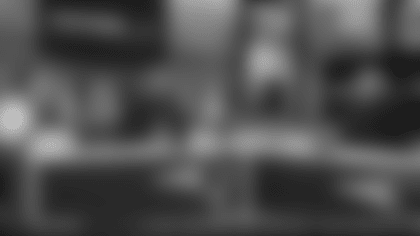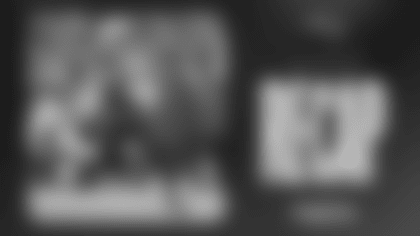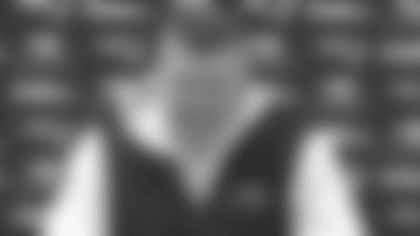NC: Good afternoon. I appreciate you being here. [It's a] busy week, I'd say, on a number of different fronts. It's probably an exciting time for you guys that cover a lot of things with the team, [with] the draft and the [White House] trip tomorrow. We're just kind of winding down here with the process, a little over a week out with the draft. We're just trying to finalize some of our preparations. Most of the information we've accumulated to this point. Now it's a matter of kind of consolidating everything and sorting through everything and kind of putting our plan together in for next week, which we all know that that can be kind of a moving target relative to where we're scheduled to pick and what happens in front of us. A lot of people put in a lot of time and a lot of effort. I'd certainly be remiss if I didn't recognize [director of college scouting] Monti Ossenfort and his staff. Monti took over for Jon [Robinson] in that role last season and the transition is going really well. Monti and his staff have put a lot of time and a lot of effort, and there are a lot of people that are involved in this process, but certainly he's involved and kind of spearheading that process. The way he's worked with [head coach] Bill [Belichick] and myself has been great. We're excited about the opportunity here to find some payers that we hope can improve our team. There are not as many spots as there have been in the past, just from our overall roster standpoint. I think we're at like 73, right around near 73, 74. I think in years past, we've been a little bit lower, but the roster is a little more full relative to where we are in the overall process. Right now we have nine picks. We'll see how that goes, if we end up using those nine picks, and then there will be some players that we sign after the draft. So, there are probably another 15, 16, 17 slots, and then I'm sure there will be some things after the draft that transpire. The team-building process is an ongoing thing. This is one portion of that. Even if you'll go back to last year, kind of how we built the team, there are some players that we added in the draft, some players we added after the draft, some players we added throughout the course of the season. So, I would say the overall team-building process is a pretty extensive, ongoing thing. It kind of never ends. This is kind of just more of a definitive point in time and we kind of have a little bit better idea of what we're talking about. I would say that's kind of where we are for the time being. I'll take some questions here moving forward.
Q: Subtracting Darrelle Revis and Brandon Browner from the team and then adding some other veterans, how do you feel about where you guys stand at cornerback?

NC: I think we've added some players, I'd say, across positions that have experience in the league, that have played a number of snaps. The reality is we just started working with the players here Monday. I mean, not even working with them, they go in the weight room and started doing the strength and conditioning. We'll have a better idea when we actually get on the field, start working with them in the coaching sessions and then going into the OTAs. The players that we added to the team, we brought them here for a reason because we think they can help. Obviously we're going to let the competition sort itself out. We'll have a better idea here once we get a little bit further down the road.
Q: Is Malcolm Butler someone you're counting on to have a bigger role this year?

NC: If you want to talk about the rookies specifically, players that were in their first year in this program moving into their second year, you want to see them make some progress. Like I said, we're kind of in a long process. We've got a long way to go. We'll see how much progress one player has made relative to another. We'll have a better idea once we actually get on the field and start working with them. Everybody is going to have the same opportunity. Everything is in front of them, so once we get the opportunity to work with them collectively, then we'll see how it goes.
Q: What are some of the stronger positions in this draft? Also, how is the group from the 20th overall pick to maybe the 45th or 50th overall pick? Is that a strong group?
NC: I'd say it's probably similar to most years. I think most drafts, just generally speaking, there are probably, let's call it eight to 10 players that everybody has a conviction about. I mean, look, you guys have seen all the mock drafts. Everybody has got an opinion. It seems like there are 50 mock drafts out there, and if we took a poll of everyone and went one to 32, none of them are going to look the same once you get to a certain point. What you try to do is identify the players. Really what we're concerned about is role and how they fit on the team, not necessarily round or grade. Let's figure out the player, let's define his role. What's this player going to be for our team, and then where that player eventually ends up falling in the draft, well that's just part of the overall process. I'd say there are going to be players at multiple levels that you feel could come in and help your team. Maybe there are some that are a little bit further along the others. But I think the draft process in and of itself, just talking to that 20-45 range, I think you're going to find quality football players within that range. In the end, the most important thing for us is what's the role for our team, how do we see that player, and then we make a determination based on that.
Q: How do you evaluate a player who could come in and play right away versus a player that you would have to develop?
NC: Even when you draft a player, you really don't know. You could say, 'OK we've graded this player such and here's what we think his role is going to be,' and then he comes in and maybe it takes him a little more time than somebody else. There are certain players that are at different levels – maybe a player switching a position – so that learning curve is going to be a little bit farther than somebody who has played the position for three or four years. So, you evaluate the skills, you try to identify and say, 'OK this is what we think he's going to be able to do.' But sometimes it doesn't work out the way that you [think it's going to] go. I'd say there's a multitude of factors that go into that. Maybe it's making a position switch, maybe it's a learning element, just how quickly he learns. Because the reality is once you get them here, you think you know what you have, but you really don't know until you actually get your hands on them and can actually start to work with them. Maybe that player retains information better than others. Maybe another player, it takes them a little bit longer. Until you actually start to go through the process, which is pretty exhaustive – meeting, installation, walk-through, practice, make the correction on film, come back the next day and see if they can actually make some improvements. So, how quickly they do that, it varies from player to player. There are certainly some players who are more ready than others – or you think that they are – versus anther player. Maybe it's a lower level of competition, or like I said, he's making a position switch. You just sort of have to make that determination and that goes in turn with what the value is for our team and how he's valued according to our scale.
Q: How do you evaluate the cost of moving up to draft a certain player, and how much time do you spend talking to other teams as potential partners to move up and down?
NC: I would say any time you move up or down, it's really usually player-specific or player-driven. If there are players that you've graded a certain way or that you've valued a certain way relative to other needs, other teams, supply and demand at that position, that can dictate whether or not you feel it's necessary to move up. Or, if you feel like you could get a similar value or similar player at a lower level and accumulate picks, then you can move down. A lot of that, too, is where are you in terms of your overall roster? Like I said, we're not talking about [an] infinite number of spots. So, if you move back you're going to accumulate picks. Maybe if you move back, you use those picks to move back up, so there is a lot of jockeying that goes on. A lot of that in the end is player-specific and player-driven. If there is a player in that range and then you look at what's around you and you look at another team and you might think based on your research, 'OK, they have a need and we've sort of identified this player with that team. OK, maybe this is an opportunity to do it.' That kind of is the impetus to make that move. If you don't feel that way, you might say, 'We feel confident if we sit here we can get one of three or four players.' I think that's kind of how it transpires. I would just say from our perspective, there isn't a lot of dialogue or conversation. I would say to this point we haven't talked to too many teams. Next week, will we talk to a team or two? Possibly. But like I said, until you actually get into the draft and get into the process and the players start to come off the board, it's kind of hard to say, 'Yeah, we'd like to move up.' 'OK, well we'll get to back to you.' Then you're talking in circles, and it's kind of a wasted phone call.
Q: Does the 32nd overall pick have more value in today's NFL than it's had in the past?
NC: I think it depends on how you define that.
Q: Well, with the CBA and it's also the last pick of the night, maybe it's become more valuable just around the league.
NC: Look, in the end, you're going to pick a player. Forget about all the other variables that are involved. If there is a player there and you think he makes sense for your team, then you're going to pick the player. So I wouldn't say it's driven by any other factors. The reality is we're always prepared to pick wherever that is – 22nd, 25th, 32nd – wherever that might be. We'll be prepared to pick. If it works out that way and we have to pick the player, then we'll pick. If we don't pick, then you guys will be all pissed off because you won't have anything to write a story about the next day except that we traded out of it.
Q: If there is a guy you can get at 32, but you also may be able to get him at 40, how does the length of contract terms factor into the decision?
NC:There are so many variables that are involved. In the end, even if you want to move back, if there's not a partner, then there's not much that you can do about it.
Q: Where do the extra years factor in? If you can tie a guy up for five years in the first round, but only three years in the second round, how does that impact your decision?
NC:The reality is you look at the player, you assign a value, you say, 'Here's his role.' I would say the economics aren't really that much involved, at least from our perspective. Maybe [they are] for some other teams.
Q: What is Dante Scarnecchia's role in the draft process?
NC: I'd say that there are a lot of people that have been involved in the process this time of the year. Every coach in the building has worked out players. I'd say there are a number of people in the personnel department that have actually worked out players. Dante has a lot of experience in our system. He's a great resource. He's been a great resource for us. So, it's something that we decided that might be helpful to us in the entire process. Dante has a lot of experience in our system, and he has a lot of insight, so I'd say it's kind of worked out. There are a lot of people that were involved. All of us, every single one of us were … We can't cover everybody, so we're trying to take our resources and allocate those resources the best we can to try to get as much information as possible on a player however we can do it.
Q: What is the value of a pro day versus watching tape? Now, we're seeing networks go live from college pro days, but what is the benefit for you?
NC: I think it depends. Really, there are some players who, if they weren't at the combine, they weren't at an all-star game, so this is like their one opportunity to kind of go through the testing process. I'd say that pro days, from our perspective, I mean, yeah, you get the times and you get the information, but if you go to a pro day, you're really trying to allocate time with the player. Look, it's not necessarily how high he did the broad jump and the vertical jump. Let's say you have an opportunity to go to the school and you meet with the player one-on-one the night before or what have you and you go through an installation. OK, we're going to install these concepts. OK, we're going to go through their information, how do they process that. Then we're going to test them. Then we're going to walk through. I would say that is more helpful and advantageous from our perspective than letting the guy go out there and take his shirt off and running a 40 and getting time. There are always going to be some players in the spring that, you go in the school in the fall and maybe the guy hasn't played that much – he just doesn't have that much experience playing – but they tell you, 'Look, this guy is going to really test well in the spring.' Then, maybe you get the jump on that player and it verified what they told you. This guy tested really well. Then the question becomes, 'Well, if he tested well, why didn't he play? What happened there?' Then you have to go back and research and try to figure that out. The pro day in and of itself, it's like the combine. It's become kind of a media creation, a little bit of a circus. You try to get in there and get what you need to get done accomplished. Like I said, the bottom line is, if a guy has played three years in the SEC against good competition and then he has a bad pro day, are you really going to downgrade him because he didn't run a good 'L' drill? Probably not.
Q: Has there ever been a situation in your draft room where it got a little uncomfortable with the time clicking down, where you're like, 'Oh crap, we have to get this pick in.'?
NC: I think maybe two or three years ago. The only time that really happens is when you're making a trade, because when you make a trade with another team, you have to work with that team and you have to have correspondence with the league. If we were doing a trade, the both of us would have to call it into the league, and you can't really consummate the trade until you have both parties say, 'OK yeah, we got it.' So, if you're working with another team and you're waiting to hear back from them and the clock is running down and it says one minute, OK, well what are we doing? Once a trade gets consummated then you can turn a card in. Those are the situations where it becomes a little bit dicey, but if you're not doing a trade, usually the clock isn't an issue.
Q: Last year going into the draft, you guys said that you felt you had a pretty complete team. Do you feel the same way this year, or are there some more pressing needs?
NC: I'd say we're in a similar situation. Like I said, the roster is even a little more full than last year at this time. There are a lot of players that have a lot of experience. They haven't necessarily played in our system, which kind of goes back to the earlier question we talked about. We'll have a better idea once we're actually on the field with them to see how far along they are. But, I think we feel the players that are in this locker room, some have played a lot of football for us, some are in earlier stages of their development, and then we have some other players from other teams who we've acquired that have a lot of experience, but we're not sure how they're really going to fare in our system. If we had to go out there and play today, we could play. But the season doesn't start today, so we'll continue to build the team and try to do what we think is best for the organization.
Q: If you have a group of young players at a position that are not finished developing, does that impact your willingness to draft a player at that same position?
NC: I would say not necessarily. You're evaluating players sort of independently of one another. You know what you have on your team, so maybe it comes down to, 'OK this is what we have on the team, but there's this player over here,' And maybe if it's two positions, maybe there is a position where you have less numbers or less volume, you err on the side of caution in that respect. You look at them independently, you evaluate the player irrespective of what you have on your team. It's kind of like what we talked about a few years ago with Nate [Solder]. We had Sebastian [Vollmer], we had Matt Light and we were going to have Matt Light. So we had two good tackles, starting-level tackles that have played at a high level. Then you add Nate Solder. So, here's a third tackle that you're bringing in who you feel has good ability. Is he better than Light or Vollmer? Maybe, maybe not. But we know at some point this guy is going to be a good football player. So, it's very similar to the example you just kind of illustrated. You look at the player, you evaluate the player, you look at your team, and ultimately you're going to say, 'Look, this is the best player for our team,' and you go ahead and pick them, regardless of the position.
Q: There aren't too many personnel executives in the league that are out there in shorts running the drills at pro days, but we've seen you out there this spring doing that. How much do you enjoy that part of the pre-draft process?
NC:Whatever I can do from my perspective to help as part of the evaluation process, I'm going to do. I've been fortunate to be in the position I'm in here for a number of years. All of us – Bill, myself, coaches – when you go to a workout or go to a pro day, none of us are above any of that. If I've got to throw some balls during a drill, then I'll throw some balls. Whatever needs to be done during the course of a workout, I'm going to be willing to do it. Look, it's a good exercise for me and it kind of keeps me in decent shape. It's definitely an enjoyable part of the process. I love doing it, love being a part of it, but whatever I can do to help the team, then that's what I'm going to do.
Q: You signed a contract extension in the fall through 2020. You probably could have had other options. Some people in your position have left for GM jobs elsewhere. What about being here made you want to stay in New England?
NC: A lot of things. I would say I've been fortunate to be able to be in the same organization for 14 years. I've had a chance to work on a multitude of levels. The Kraft family has been extremely generous to me and my family, and there is no other coach in football that I'd rather work alongside than Bill Belichick. I like being here, I like winning and I enjoy my role. I have plenty of responsibility, and I enjoy being a part of a winning culture and winning organization. I feel blessed. To be here and to have the opportunity that I have, I'm really grateful and hopefully we can continue to win some games along the way as well.
Q: When you look at past drafts and you see a position or two that you haven't hit on, especially early on, what do you do work on that and improve it to make sure it stops as quickly as possible?
NC: It's an ongoing process. We try to look at the scope of what we're doing on every level – coaching, playing, training, scouting – and figure out where was there a gap or what could we have done a little bit differently. The evaluation process of what we're doing, it's not yearly; it's daily. Did we overvalue the player's ability? Was it his ability to conceptualize and learn something? Was it something else outside of football? It's never one factor. There are always a multitude of factors. So you just try to look at that example and say, 'OK, well here's what we thought and here's what it ended up being.' Look, nobody is a draft expert. I know there are a lot of experts out there, but the draft is an inexact science. That's the reality of it. There are going to be players that work out the way you think, and then there are going to be other players that don't work out the way you anticipate. You just try to go back and then figure it out. It's the same thing after a game. We played poorly in this game. OK, here's the evaluation of this game. What did we do well? What did we do poorly? Here are some things that we can work on. That mentality sort of transcends every aspect of the organization, and it's no different than what we try to do from our perspective. The idea is to try to make continual improvement and try not to repeat things that continually pop up. And if they do, then we just have to figure out a different mechanism or method to get to the bottom of it.




































